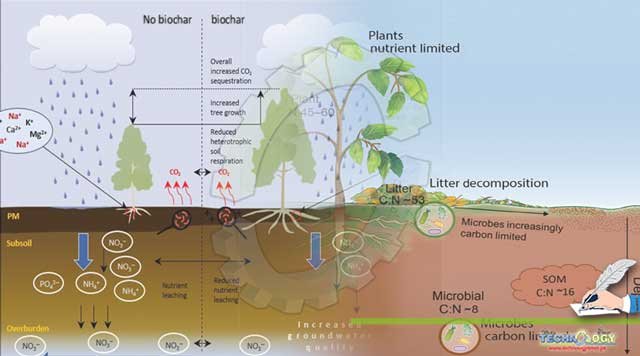Biochar can helps to reduce climate change, which can prevent major changes to our home planet. Increase in soil fertility can help to reduce the problem of food security and by solid waste management by turning it into biochar

Biochar
Biochar is a charcoal like substance that is formed by transforming organic materials under oxygen-free environment at a low temperature (< 700 0C). The physical, chemical and biological changes in biochar are due to difference in the temperature that is used for pyrolysis
Properties of Biochar
Type of feedstock and temperature treatments are the two factors that rules over the physical and chemical properties of biochar.
Chemical properties
Atomic ratios:
The procedure of formation of biochar includes many refinements in its chemical structure, which involves detachment of various functional groups.
Elemental compositions:
As there is an increase in the reaction temperature which results in an increase in carbon content (> 95%), while there is a decrease in hydrogen and oxygen content (< 5%).
PH value:
There is an increase in pH value of biochar as the temperature increases. It is due to the acidic functional groups that are detached during pyrolysis. So there is an increases the ash content. Highest pH is obtained in a range of 10-12 at a temperature of more than 500 0C.
Cation exchange capacity:
It is the amount of exchange able cations that a material can hold. This is the result of the negative charges attracting the cations. Biochar that is produced at a low temperature have highest cation exchange capacity. As there are enough functional groups that provide negative charge.
Ash content:
It is largely dependent on parent biomass and on the harvesting technique that are used. Ash content increases with the increase in temperature.
Physical properties
Pore volume and pore size distribution:
The pores are divided into 3 types on the bases of there size. First one are the macropores (pore diameter of 1000-0.05 μm), then there comes mesopores (pore diameter of 0.05-0.002 μm), and the third one are the micropores (0.05-0.0001 μm). Total pore volume increases with increase in temperature. The Pore structure of biochar contains many micropores (more than 80 % of total pore volume).
Surface area:
Surface area of biochar is increased with an increase in the temperature. However after an initial increase the surface area of biochar decreases at high temperature (800-1000 0C). Large surface area is also concerned with cation exchange capacity or water holding capacity.
Thermal conductivity and heat capacity:
The higher density of the biochar is also linked with higher conductivity. As a result, the formation of porous structure leads to decline in biochar thermal conductivity as compare to there parental biomass. The power and heat value depends on the temperature at which the measurements are carried out. This was proved by Dupont et al., who calculated that at room temperature the heat potential of wood biomass was about 1300 J/(kgK) and the biochar that was generated at 500 °C had a potential of about 1000 J/1 (kgK)
Advantages
It is much cheaper than activated carbon. The cost of producing biochar is about one-sixth of the activated carbon that is commercially available in the market. It is obtained at low temperatures and does not requires further processing to activate it. Adsorption is seen for both organic and inorganic contaminants. Biochar comprises a non-carbonized fraction that interacts with soil contaminants.
Biochar is capable of promoting living microbiology in the soil as It helps in strengthens the network of food in the soil. It has a higher water holding capacity as compare to the activated carbons. Its density is low, so it provides good aeration. It decreases the nutrient loss by leaching. Biochar produced from waste such as sludges and manure has a high nutritive value. It also improves the quality of the soil.
Conclusion
Work has been done both locally and worldwide in the area of biochar. Biochar has produced under insufficient or no oxygen (usually at below 700 °C) from the substances such as plant waste, animal waste and even algae. Biochar properties are influenced by the temperature of pyrolysis and the type of biomass that is used to produce biochar. Characterization of biomass may be used for particular applications such as cost efficient hydrogen sulphide separation from bio-gas. Some modifications can improve the specificity of the biochar. For example, a two-step thermal technology has been used to prepare spherical biochar for potato peel waste. In addition, magnetic biochar has been developed that can be easily retrieved using external magnetic field. Furthermore, there is a desperate need for comprehensive research to better solve any problem resulting from its use.